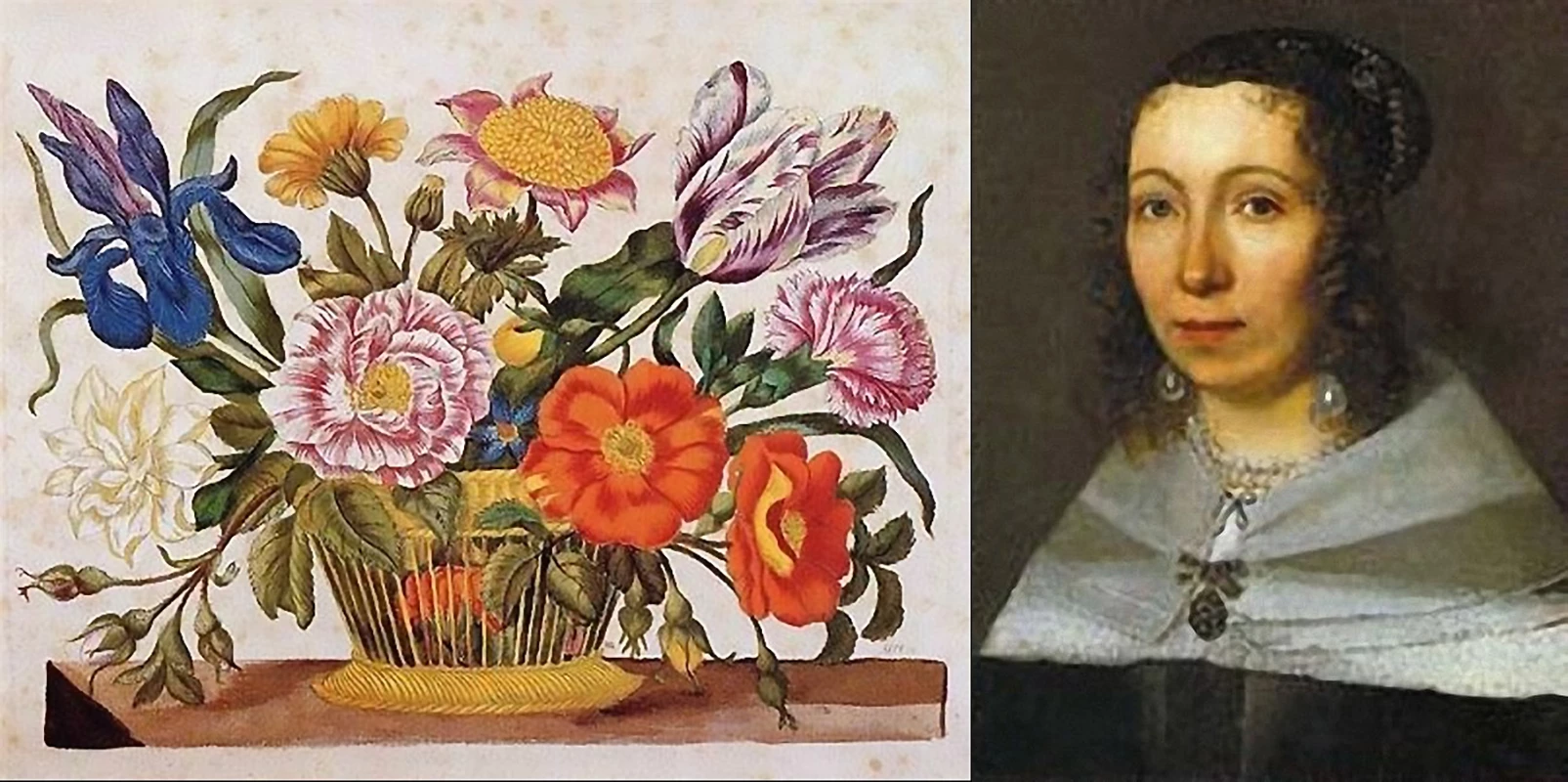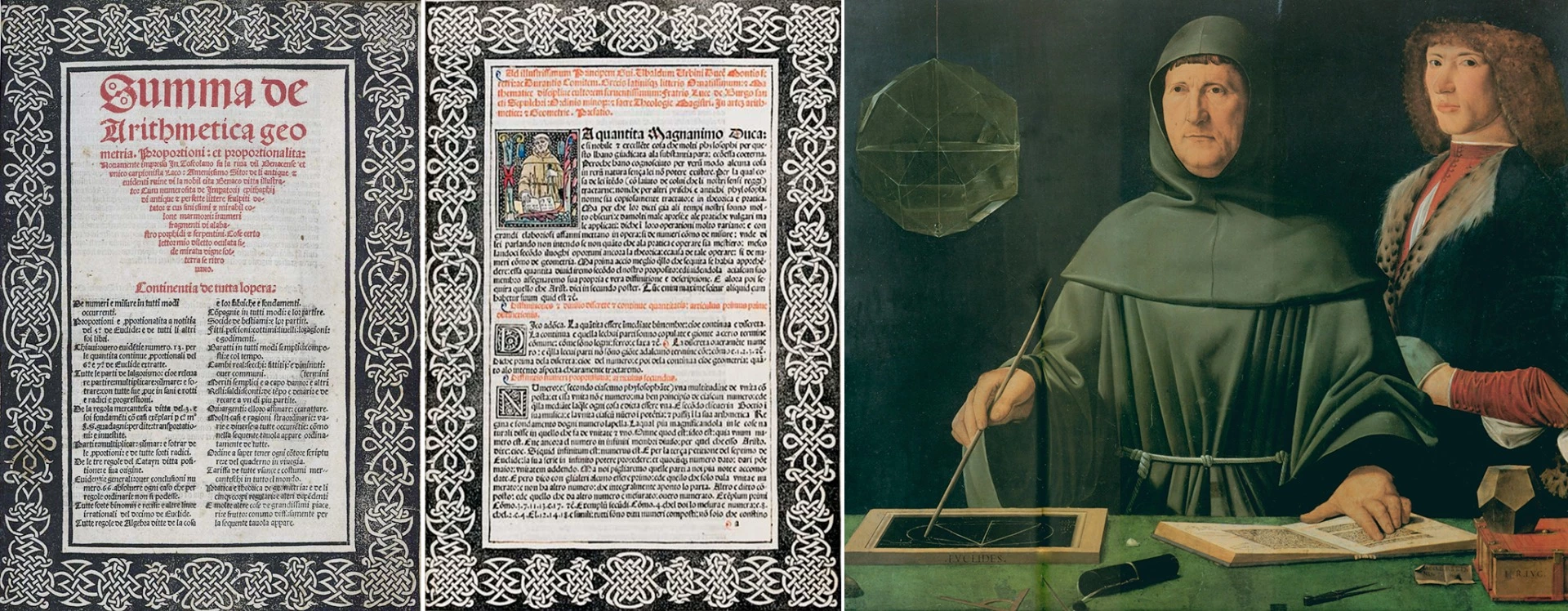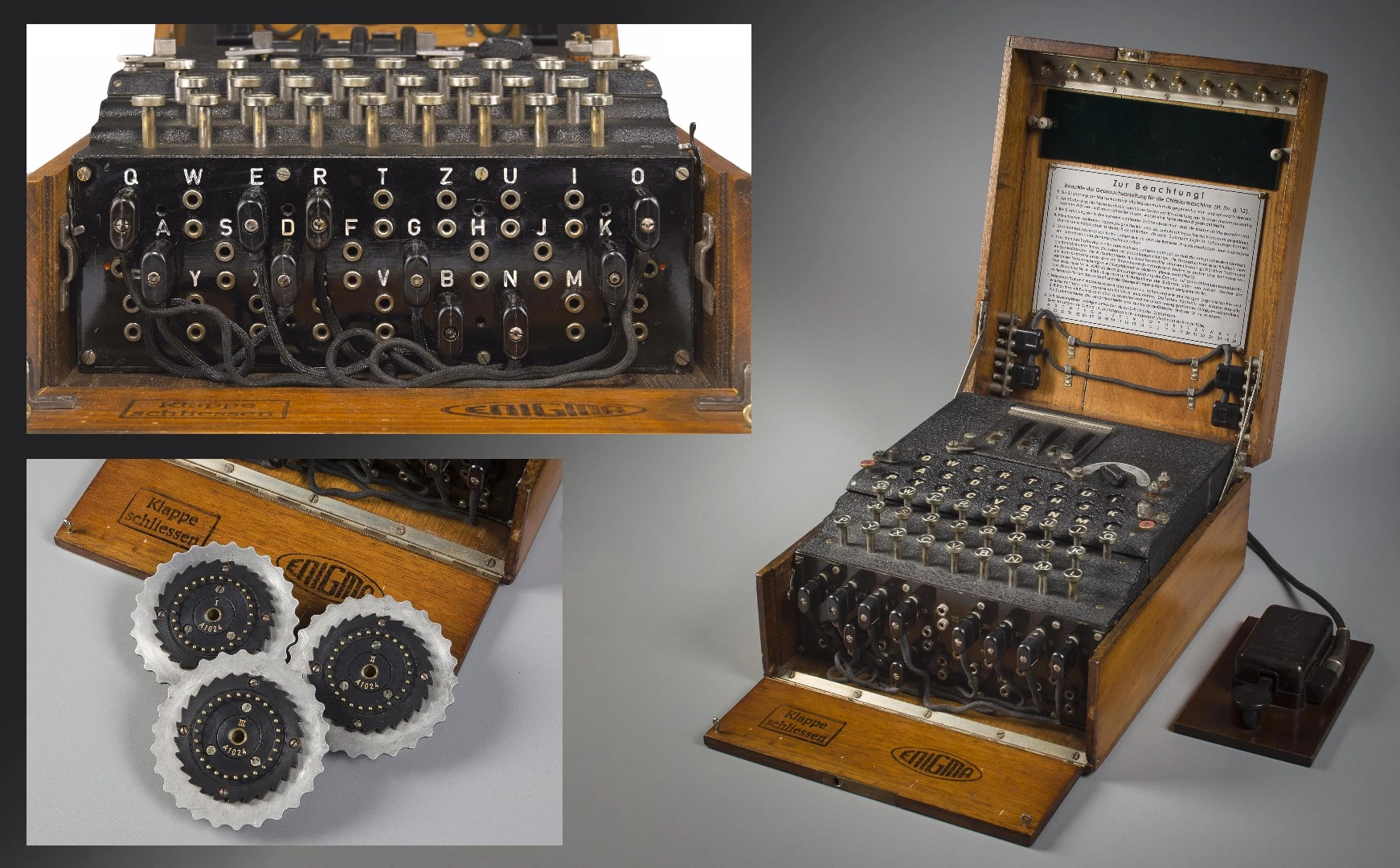UPDATED January 13, 2018 | In the third installment of our six part-series series covering the most valuable scientific documents of all-time we encounter works from Aristotle and one of history's greatest female scientists, along with the first "accurate and complete" map of the world.
This is the third of a six-part series covering the most valuable scientific documents and manuscripts from #40 to #31. The introduction to the marketplace is the first part of the series, followed by the most valuable scientific documents and manuscripts from #50 to #41, The most valuable scientific documents of all-time #40-31, The most valuable scientific documents of all-time #30-21, The most valuable scientific documents of all-time #20-11 and The most valuable scientific documents of all-time: top 10. You may also like, The 50 most valuable scientific documents of 2016 and The 50 most valuable scientific documents of 2017.
40 - De architectura by Marcus Vitruvius Pollio

Price: $881,000
Estimate: $200,000 - $300,000
Created: circa 30 BC to 15 BC
Auctioned: Christie's (New York), December, 2007
Significance: Written 2000 years ago by Roman architect and military engineer Marcus Vitruvius Pollio, De architectura (On Architecture in English, but published as Ten Books on Architecture) is the oldest surviving treatise on architecture and certainly the most influential book ever written on the subject. Included within the ten books is a clear understanding of how advanced the Romans were in areas such as town planning and civil engineering, water supply and aqueducts, geometry, astronomy and the construction of machines as diverse as siege engines, water mills, drainage machines, hoists and pneumatic devices.
The book was reproduced repeatedly with commentary once the printing press was invented 1500 years after it was written, and Italian Renaissance architects such as Alberti, Bramante, Michelangelo, Vignola, Palladio and many others were influenced by it. Even the White House owes much to Marcus Vitruvius Pollio.
39 - Atlas Major, Sive Cosmographia Blaviana by Johannes Blaeu

Price: $883,944 (£581,000)
Estimate: £240,000 — £320,000
Created: 1662
Auctioned: Sotheby's (London), November, 2015
Significance: This book is one of the many remarkable achievements of a father and son who contributed so much to our understanding of the world. Both Dutch cartographers, atlas and globe makers and publishers, Johannes Blaeu (1596 – 1673) was the son of cartographer Willem Blaeu.
The Atlas Major was published between 1662 and 1672, in Latin (11 volumes), French (12 volumes), Dutch (9 volumes), German (10 volumes) and Spanish (10 volumes), containing 594 maps and around 3,000 pages of text. It was the largest and most expensive book published in the 17th century and is accurately cited in the auction description as "the most famous atlas in the history of printed maps" and "the most magnificent work of its kind ever produced."
The work covered the known world, with particular emphasis on Europe, but with important volumes devoted to America and another to China. "The contents of this unprecedented atlas illustrate the high standards of contemporary cartography and geographical knowledge, and its presentation bears witness to the superb craftsmanship of engraver, printer, binder and papermaker ... The costly atlas was in fact exclusively designed for those members of the patriciate who could command both the material and intellectual resources that were needed to buy it and appreciate it." (Koeman II, pp.1-3)."
Some 300 sets are believed to have been published, many of which were presented throughout Europe as a tangible symbol of the Republic of the United Netherlands.
38 - The Moller Floregium by Hans Simon Holtzbecker

Price: $898,963 (£551,500)
Estimate: £500,000 - £700,000
Created: circa 1650 - 1670
Auctioned: Christie's (London), March, 1999
Significance: It's fitting that the best known work of Dutch horticulture artists Hans Simon Holtzbecker and Maria Sibylla Merian should fetch similar prices at auction, as their work was intertwined in many ways. Much of Holtzbecker's work was attributed to Merian for many years, then some of Merian's work was attributed to Holtzbecker. This particular work, the Moller Florilegium, was thought lost until it came up for auction and was described in the catalogue as "a botanical album of outstanding beauty ... a rediscovered masterpiece and a significant addition to the newly identified oeuvre of one of the finest botanical artists of the 17th century, Hans Simon Holtzbecker."
37 - Neues Blumenbuch by Maria Sibylla Merian

Price: $925,826 (£565,250)
Estimate: £60,000 - £90,000
Created: In three parts between 1675 and 1680
Auctioned: Christie's (London), June, 2011
Significance: Though Neues Blumenbuch is not the best known work of German-born naturalist and scientific illustrator Maria Sibylla Merian (1647 – 1717), it was her first book (published when she was just 28) of many, and by far the rarest. This particular copy is the only extant copy of the three-part first edition, and is believed to have been hand-colored by Merian herself, making it a genuine treasure, which is reflected in the price it fetched. The only other copy to appear at auction in recent times was one of the subsequent composite publications of all three parts produced in 1680 which sold at a Christies London auction in March, 2000 for £166,500 ($261,373).
In 1699, Merian traveled to the Dutch colony of Suriname in South America to observe and illustrate new species of insects, becoming arguably the first person in history to undertake an epic journey solely for scientific purposes. Her five-year expedition was cut short after two years when she contracted malaria, but the resultant publication of Metamorphosis Insectorum Surinamensium upon her return to Amsterdam became a foundation for the science of entomology. Like the other female on this top 50 list (Émilie du Châtelet), Maria Sibylla Merian overcame the many seemingly insurmountable gender-bias obstacles of the era to make an immense contribution to science. She worked in watercolors, for example, because oil paints were unavailable to women. Indeed, Merian was not at first recognized for her work, having been "discovered" for her contributions to botany and zoology several centuries after her death. She is now regarded as one of history's greatest female scientists, but despite being the first published woman naturalist, she died a pauper. Peter the Great of Russia was the first to recognize Merian's work and he purchased many of her watercolours, which now reside in the Kunstkamera Museum of Anthropology and Ethnography in St Petersburg.

Some perspective on the price: This Louis XVI Ormolu Striking Table Clock is part objet d'art and part scientific instrument, with a calendar, moonphase, equation of time and terrestrial "sphere mouvante". It was created in Paris circa 1770 – 1775 by Jean-Matthieu Mabille and Martin Baffert. It sold at a Christies (London) auction in July, 2015 for $926,440 (£602,500)
36 – De animalibus by Aristotle

Price: $941,000
Estimate: $300,000 - $500,000
Created: Written circa 350 BC, printed 1476
Auctioned: Bonhams (New York), June, 2016
Significance: Though this book was translated into Latin by Greek scholar Theodore Gaza and printed in medieval Italy in 1476, it was written 2,400 years ago by the world's first true scientist, Aristotle (384 to 322 BC), and is unquestionably the foundation of the scientific study of biology. According to the Stanford Encyclopedia of Philosophy, this book provided the "first systematic and comprehensive study of animals. There was nothing of similar scope and sophistication again until the 16th century."
35 - Summa di aritmetica geometria proporzioni e proporzionalita by Luca Pacioli

Price: $953,910 (£534,400)
Estimate: £120,000 — 170,000
Created: 1494
Auctioned: Sotheby's (London), October, 2005
Significance: This particular example of Franciscan friar Luca Pacioli's Summa di aritmetica geometria proporzioni e proporzionalita was the dedication copy (to Guidubaldo da Montefeltro, Duke of Urbina), and has since been part of several of the greatest private libraries ever known.
This publication is of one of the most influential works of all time, being the first work on general mathematics ever printed, being written by the man who taught mathematics to Leonardo Da Vinci (pictured at Pacioli's left in the above image) and most importantly, this was the first book to offer a detailed description of the double-entry accounting system, making Pacioli the "Father of Accounting". Many of the illustrations for the book, including the elaborate drop caps at the beginning of each chapter, were done by Pacioli's star former pupil, Leonardo.
34 - Horologium Oscillatorium by Christiaan Huygens

Price: $965,000
Estimate: $150,000 - $200,000
Created: 1673
Auctioned: Christie's (New York), December, 2014
Significance: The first edition of Dutch mathematician and scientist Christiaan Huygens' (1629 – 1695) most important work contains the first mathematical analysis of the motion of the pendulum, and a general treatise on the dynamics of bodies in motion. The auctioned copy that fetched $965,000 was Huygen's personal copy and is annotated on 20 pages in his handwriting.
Huygens was a leading scientist of his time, known particularly as an astronomer, physicist, probabilist and horologist. His work included early telescopic studies of the rings of Saturn and the discovery of its moon Titan, the invention of the pendulum clock and other investigations in timekeeping. He published major studies of mechanics and optics, and produced a pioneer work on games of chance, De ratiociniis in ludo aleae (On Reasoning in Games of Chance) in 1657.
33 - Astronomicum Caesarum by Petrus Apianus

Price: $984,000 (€800,000)
Estimate: Not Available
Created: 1540
Auctioned: Thomas Scheler (Paris), 2004
Significance: Petrus Apianus (1495 – 1552) produced significant works in both mathematics and cartography during his lifetime, but it was at the University of Ingolstadt where as Professor of Astronomy, he built his own printing business and produced one of the most innovative works in printing history: this book, the Astronomicum Caesareum (Emperor's Astronomy). One of the reasons this book is not even more valuable is that it was so obviously a masterpiece of both printing and ingenuity that more than 120 copies have survived. Pioneer astronomer Tycho Brahe (1546 – 1601) records that he paid 20 florins (roughly $3000 in today's money) for a copy.
Upon developing his printing works, the ingenious instrument maker and mathematician quickly recognized the possibilities of creating paper calculators within his books and had already evolved and published a number of books containing these volvelles (essentially, paper analog computers). Astronomicum Caesarum was dedicated to Holy Roman Emperor Charles V, who promised him 3,000 golden guilders (but never appears to have paid), appointed him his court mathematician, and eventually made him a Reichsritter (Free Imperial Knight) and an Imperial Count Palatine.
A detailed account of the book and its ingenious devices can be found at Atlas Coalestis written by Owen Gingerich, Research Professor of Astronomy and History of Science at the Harvard-Smithsonian Center for Astrophysics.
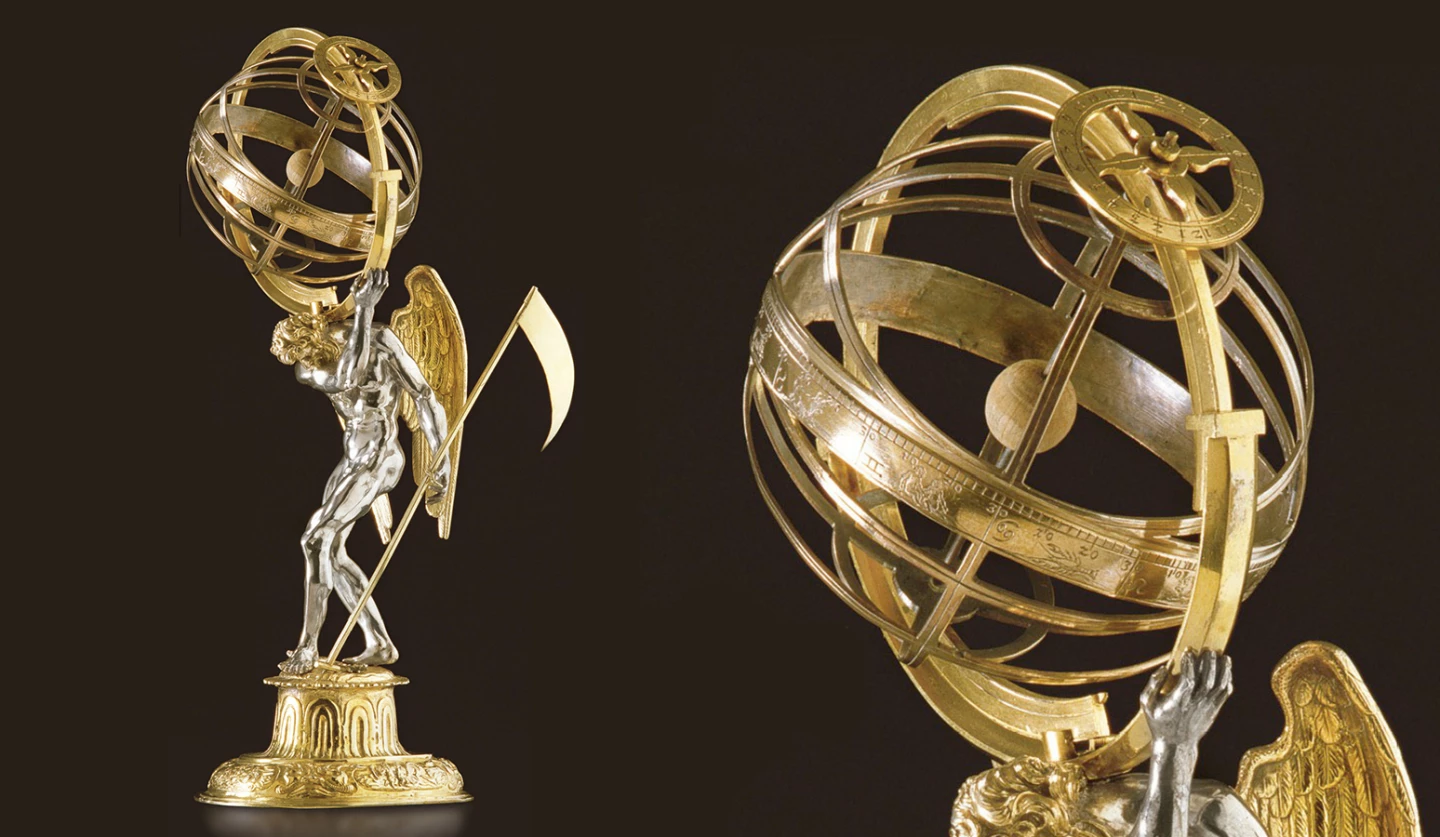
Some perspective on the price: One of the most beautiful scientific instruments of all time sold for a similar price at auction. This 34.5 cm (13½ in.) Silesian parcel-gilt statuette of the Greek God Chronos supporting an Armillary Sphere sold for $994,402 (€781,000) at Christie's sale of the Yves Saint Laurent and Pierre Bergé Collection in February, 2009. Dubbed the "sale of the century" by the art press, the collection fetched a record €373,935,500 ($476.1 million) including a Matisse painting for €35.9 million. The statuette and armillary sphere was created circa 1630, and the legend of Chronos later morphed into another well-known figure – Father Time. As an aside, this same auction featured parts of what would certainly be one of the most valuable clocks of all time, even if it might not be a scientific instrument. The sale of two bronze fountain heads from an elaborate water clock stolen from the palace of the Chinese Qianlong Emperor in the mid-eighteenth century saw them fetch €14,000,000 each, but the sale caused an international incident and ... full story here.
32 - World map in terrestrial globe gores by Martin Waldseemüller

Price: $1,001,920 (£545,600)
Estimate: £500,000 - £800,000
Created: 1507
Auctioned: Christie's (London), June, 2005
Significance: One of four known copies of a map that is a significant milestone in the mapping of the world and the only separately published map by Waldseemüller in private hands. It is the first printed globe, the first "accurate and complete" map of the world in 360 degrees, the first to show a separate South and North American continent, the first to show the Pacific Ocean as a separate entity, the first to show Cape Horn and a defined western coastline to South America and most significantly, the first map or globe to name "America".
German cartographers Martin Waldseemüller (1470 – 1520) and Matthias Ringmann (1482 – 1511) were attracted to the Church-sponsored scientific Vosges gymnasium in 1505 to work on a new edition of Ptolemy's Geographia (see number #6 on this list) combining Ptolemy's maps with the latest available from elsewhere, including the a number of Portuguese charts and at very least, a copy of Mondus Novus (New World), detailing the the voyages of Amerigo Vespucci (1454 – 1512), which was published in 1504. They were also instructed to create a new up-to-date globe and wall map of the world.
Cosmographiae Introductio, the booklet designed to provide an introduction to new geography of the world as shown in the globe and wall map, was first published April 1507 (you can view the entire copy on-line at the Library of Congress). The Cosmographiae provided an introduction to the new geography of the world as laid out in the globe and wall map, and included a Latin translation of Vespucci's four voyages. In the text, the authors explain the reasons for the naming of America: "Now, these parts of the earth have been more extensively explored and a fourth part has been discovered by Amerigo Vespucci. Inasmuch as both Europe and Asia received their names from women, I see no reason why any one should justly object to calling this part Amerige, i.e. the land of Amerigo, or America, after Amerigo, its discoverer, a man of great ability."
The Waldseemüller wall map which makes up the third part of one of the sets produced, is also available on-line at the Library of Congress.
31 - The only known composition notebook of Alan Turing
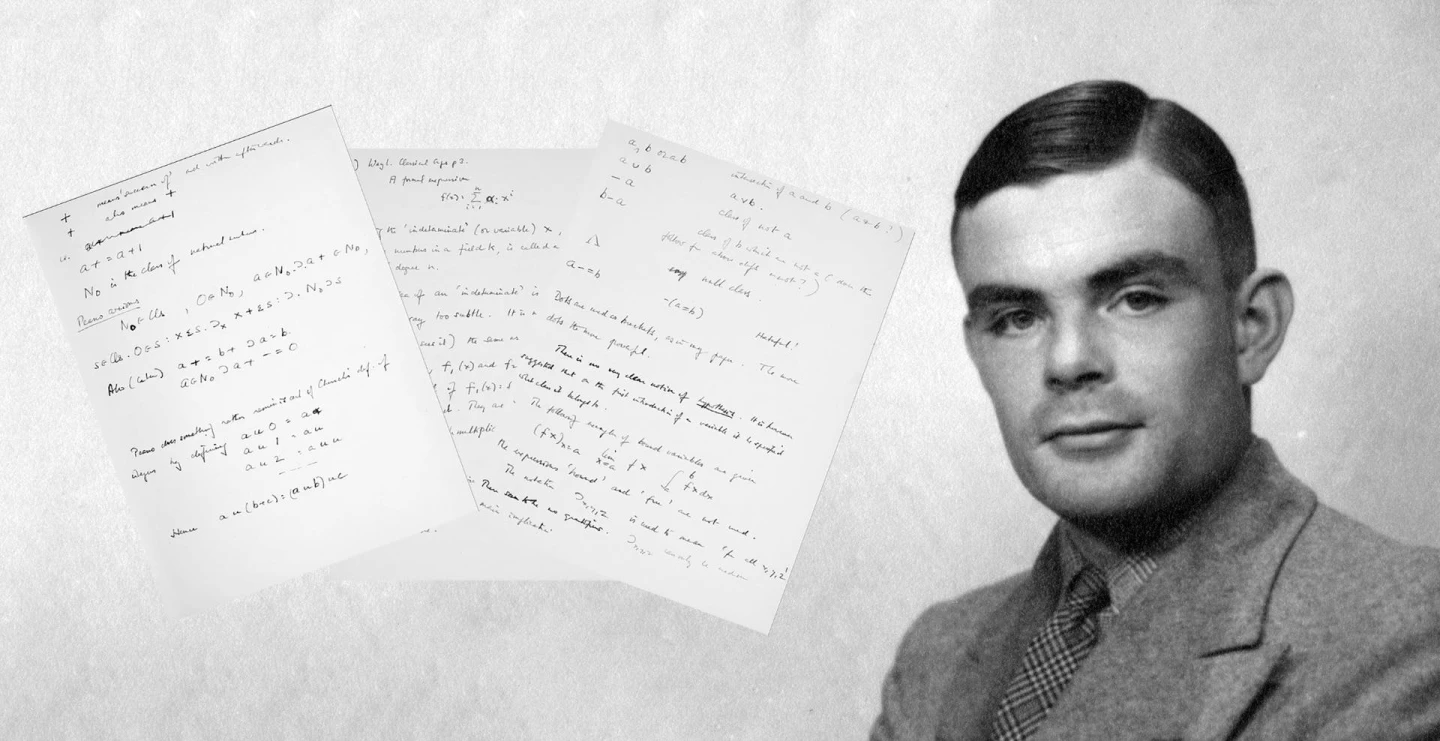
Price: $1,025,000
Estimate: $1,000,000 +
Created: circa 1944
Auctioned: Bonhams (New York), April, 2015
Significance: Turing is considered to be the father of several computer-based sciences, including theoretical computer science and artificial intelligence, and of modern computing in general. The feature film The Imitation Game introduced him to a whole new generation. This is the only surviving Turing manuscript.
It was apparent from a young age that Alan Turing possessed a prodigious talent for mathematics, long before he earned a fellowship at King's College, Cambridge, at the age of 22. In 1936, at age 24, Turing was laying the foundations of theoretical computer science, providing a formalization of the concepts of algorithm and computation with the Turing machine. From September 1936 to July 1938, Turing moved to Princeton University where he studied under Alonso Church before returning to Cambridge, joining the legendary code-breakers at Bletchley Park upon the outbreak of war in 1939.
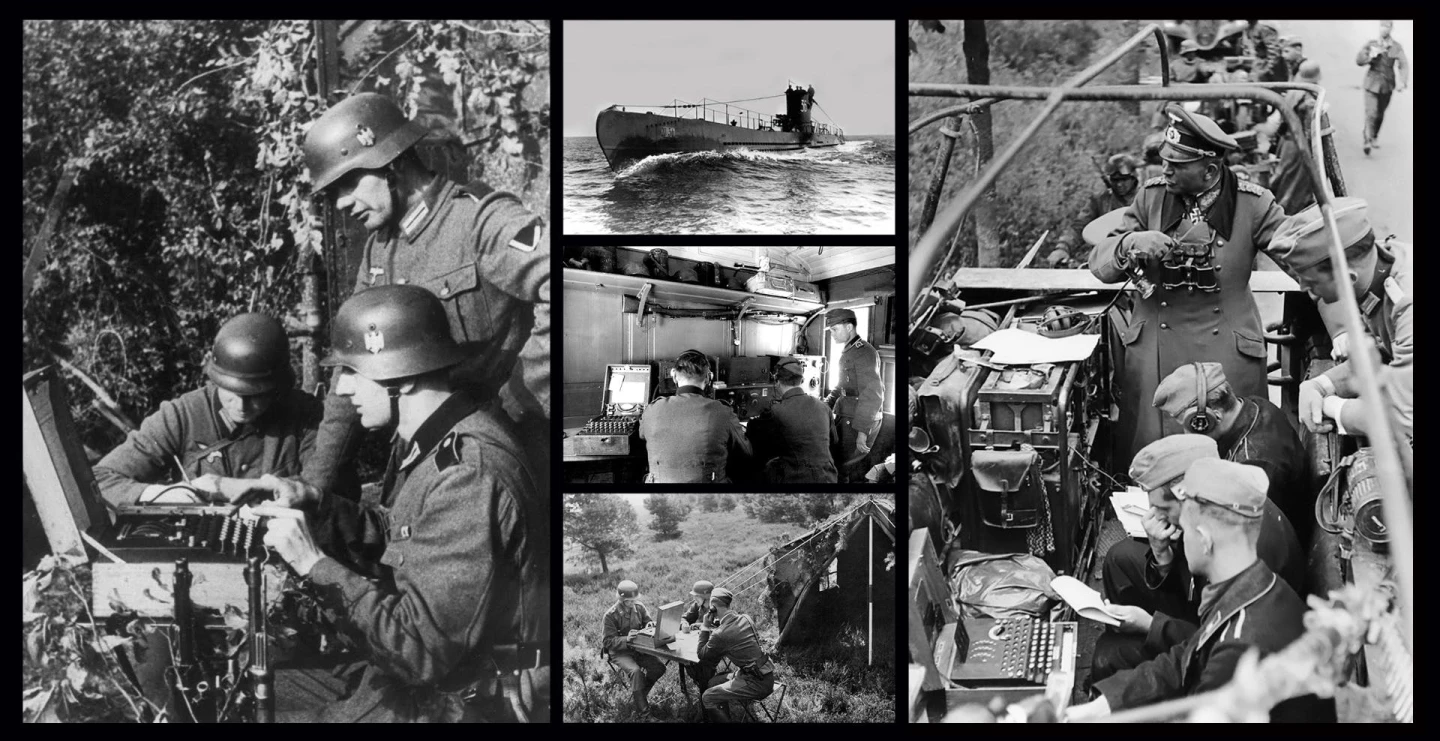
At Bletchley Park, Turing worked on an electromechanical device designed to facilitate the deciphering of messages created by the German Enigma cypher machines. Named the "bombe" in deference to its predecessor, the Bomba Kryptologiczna which was created by the Polish Cipher Bureau, Turing's own device improved on the Polish machine and through its various iterations became one of the premier code–breaking weapons in the armoury of the Allies, allowing the deciphering of many vital messages sent by Axis powers.
Following the war, his work in artificial intelligence, such as the Turing test, is still influential today. Following persecution by the British Government due to his homosexuality, Turing committed suicide at 41 years of age on 7 June, 1954. In 2009, British Prime Minister Gordon Brown publicly apologized on behalf of the British government and Queen Elizabeth II granted him a posthumous pardon in 2013.
Some perspective on the price: Some other notable auction sales near US$1.0 million include two of Babe Ruth's baseball contracts ($1.02 million and another at $996,000), Wladimar Klitschkow's Olympic Gold Medal for boxing ($1.0 million) and Muhammad Ali's gloves from his 1965 Las Vegas title fight Against Floyd Patterson ($1.1 million) – both pairs from his "phantom punch" bout with Sonny Liston fetched $956,000.
The article above is the third of a six-part series covering the most valuable scientific documents and manuscripts from #40 to #31. The introduction to the marketplace is the first part of the series, followed by the most valuable scientific documents and manuscripts from #50 to #41, The most valuable scientific documents of all-time #40-31, The most valuable scientific documents of all-time #30-21, The most valuable scientific documents of all-time #20-11 and The most valuable scientific documents of all-time: top 10. You may also like, The 50 most valuable scientific documents of 2016 and The 50 most valuable scientific documents of 2017.
Continue reading with the 4th part of the series, #30-21.




